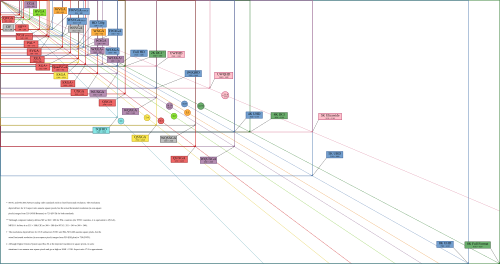List of common display resolutions

This article lists computer monitor, television, digital film, and other graphics display resolutions that are in common use. Most of them use certain preferred numbers.
Computer graphics
- Pixel aspect ratio (PAR)
- The horizontal to vertical ratio of each pixel.
- Storage aspect ratio (SAR)
- The horizontal to vertical ratio of solely the number of pixels in each direction.
- Display aspect ratio (DAR)
- The combination (which occurs by multiplication) of both the pixel aspect ratio and storage aspect ratio giving the aspect ratio as experienced by the viewer.
Television and media
For television, the display aspect ratio (DAR) is shown, not the storage aspect ratio (SAR); analog television does not have well-defined pixels, while several digital television standards have non-square pixels.
Analog systems
Digital standards
Many of these resolutions are also used for video files that are not broadcast. These may also use other aspect ratios by cropping otherwise black bars at the top and bottom which result from cinema aspect ratios greater than 16∶9, such as 1.85 or 2.35 through 2.40 (dubbed "Cinemascope", "21∶9" etc.), while the standard horizontal resolution, e.g. 1920 pixels, is usually kept. The vertical resolution is usually a multiple of 8 or 16 pixels due to most video codecs processing pixels on such sized blocks. A widescreen FHD video can be 1920 × 800 for a 12∶5 ratio or 1920 × 1040 for roughly 1.85∶1, for instance.
Films
The below distinguish SAR (aspect ratio of pixel dimensions), DAR (aspect ratio of displayed image dimensions), and the corresponding PAR (aspect ratio of individual pixels), though it currently contains some errors (inconsistencies), as flagged.
Video conferencing
CCTV
960H is a resolution used in analog CCTV equipment. 960H represents the number of horizontal pixels in a video signal transmitted from a camera or received by a DVR (Digital Video Recorder). The resolution of 960H depends on whether the equipment is PAL or NTSC based: 960H represents 960 × 576 (PAL) or 960 × 480 (NTSC) pixels. 960H represents an increase in pixels of some 30% over standard D1 resolution, which is 720 × 576 pixels (PAL), or 720 × 480 pixels (NTSC). The increased resolution over D1 comes as a result of a longer horizontal scan. The difference is that whilst D1 has a 4:3 aspect ratio 960H has a 16:9 widescreen aspect ratio. The extra pixels are used to form the increased area to the sides of the D1 image. The pixel density of 960H is identical to standard D1 resolution so it does not give any improvement in image quality, merely a wider aspect ratio.
Alternative analog video transport technologies carrying higher resolutions than 960H include HD-TVI, HDCVI, and AHD.
Notes
References
Further reading
- Myers, Robert L. (4 October 2002). "Format and Timing Standards". Display Interfaces: Fundamentals and Standards. Chichester: John Wiley and Sons. p. 132. ISBN 0-471-49946-3.
- Rosch, Winn L. (21 February 2003). "Display Systems". Winn L. Rosch Hardware Bible (6th ed.). Que Publishing. p. 827. ISBN 0-7897-2859-1.